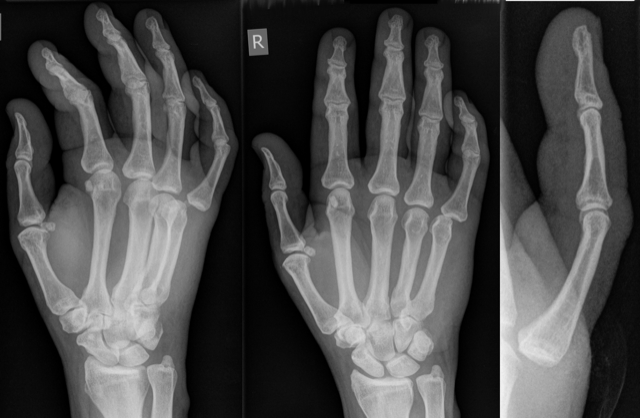Which complication is most likely during wrist reduction?
A 45-year-old male presents to the emergency department with acute injury and deformity to his fifth digit. He reports falling on his outstretched hand and the fifth digit being caught in a hyperextension mechanism.
On exam, there is gross deformity at the MCP joint; range of motion testing is not possible due to the deformity. His radiographs are shown below. Failure to flex the wrist during reduction is most likely to cause which of the following complications?
Question Answer Choices
- Digital vascular compromise
- Distal metacarpal fracture
- Extensor tendon rupture
- Proximal phalanx fracture
- Volar plate entrapment
Incorrect answer choices:
Digital vascular compromise (Choice A) is unlikely to occur with reduction of this injury. The vessels are beginning to run laterally at the base of the finger.
Digital metacarpal (Choice B) and proximal phalanx (Choice D) fractures are unlikely to occur with reduction of this injury unless the bone is particularly brittle and leverage is placed with the bone shaft as the fulcrum, which is unlikely.
Extensor tendon rupture (Choice C) is more likely to have occurred from the original dislocation. It will be very difficult to assess extensor tendon function in the current position, but all tendon function should be assessed post reduction (in addition to standard neurovascular re-evaluation).
EM Monthly Quiz Question Explanation

Correct answer: E. Volar plate entrapment
This series of X-rays show an MCP dislocation of the fifth digit. The proximal phalanx is dorsally subluxed with respect to the distal metacarpal. Proper reduction technique includes flexion of the wrist (to disengage and relax flexor tendons) and direct pressure on the dorsum of the subluxed proximal phalanx. Application of traction on the digit is an improper technique since it may allow the volar plate of the joint to become trapped into the joint space, which makes the subluxation unreducible and requires open reduction.
References
Davenport M, Tang P. Injuries to the Hand and Digits. In: Tintinalli JE, Stapczynski J, Ma O, Yealy DM, Meckler GD, Cline DM. eds. Tintinalli’s Emergency Medicine: A Comprehensive Study Guide, 8e New York, NY: McGraw-Hill; 2016.
Chapter 12
http://accessmedicine.mhmedical.com.proxy.lib.uiowa.edu/content.aspx?bookid=1658§ionid=109446343. Accessed April 08, 2020.



